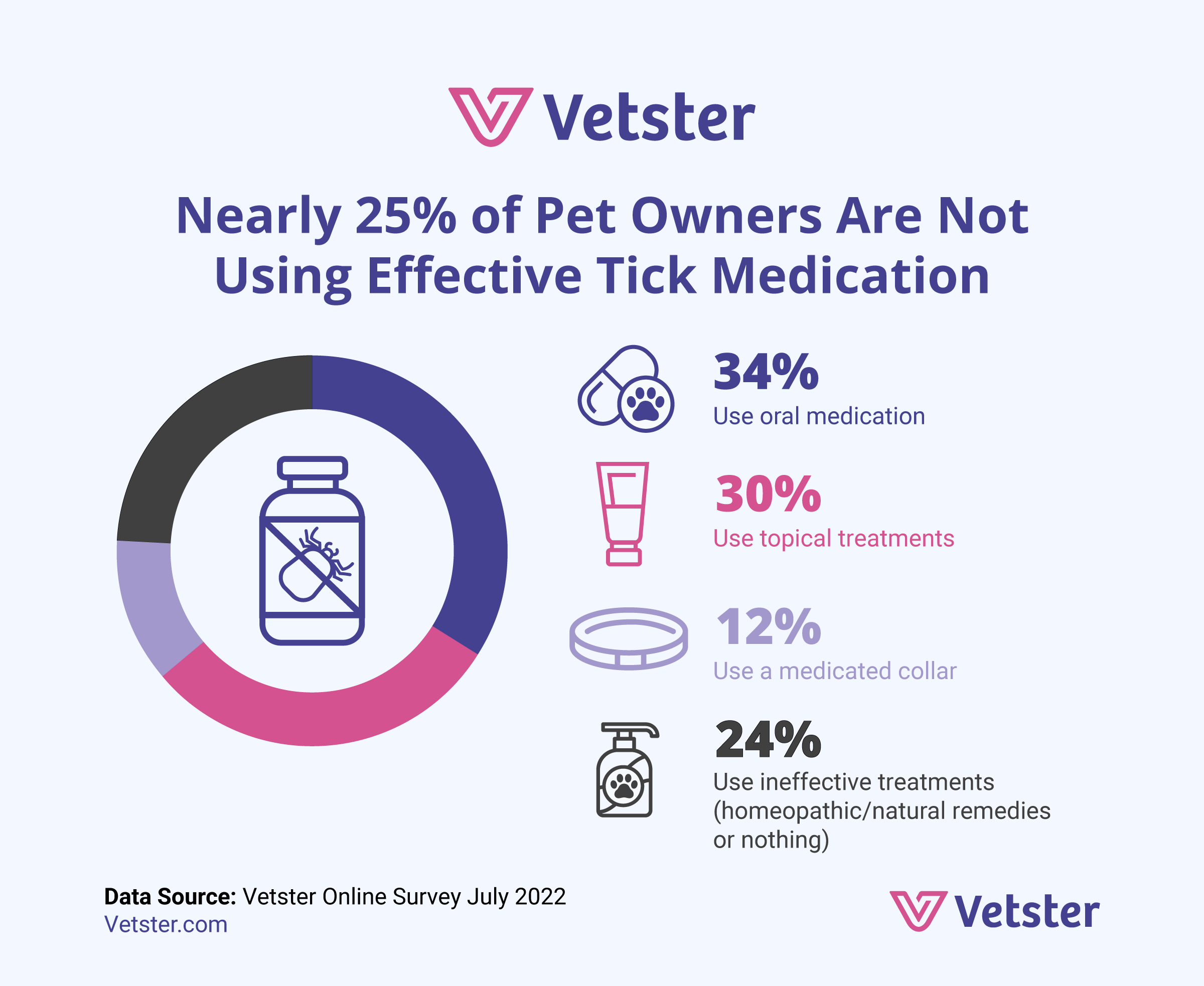What to do if your pet has ticks

While ticks are prevalent in some places year-round, regions that experience seasonal freeze/thaw cycles will see a boost in tick activity once the weather warms up. Spending more time outdoors in the warmer weather also increases the odds of ticks showing up on your pets. Taking proactive measures to deter ticks from your home and yard can help reduce exposure to ticks, and using a veterinarian-approved tick control product will further minimize the likelihood of your pet acquiring a tick-borne illness. Keep in mind that these products reduce the chances for disease transmission by killing ticks as quickly as possible, but they don’t repel ticks or stop them from biting in the first place. As a result, even if your product is used correctly you may still find a tick attached to your pet on occasion. It’s reassuring to know any ticks you find should be dead or dying - hopefully before they’ve transmitted a disease - but it’s still best to safely remove the tick and know what to expect while the site of the bite heals.

The longer a tick is embedded in your pet’s skin, the more likely it is that disease transmission can occur. Make sure to check your pet’s skin for ticks every day. Using a veterinarian-approved tick control product and removing ticks quickly and correctly significantly lowers the risk of exposure to a tick-borne illness or disease for you and your pet.
How to identify a tick on your pet
A tick is a tiny, eight-legged arachnid with a flat, oval body that may appear yellow, gray, reddish-brown, or black. Ticks attach themselves to their hosts by inserting their barb-like mouths into the skin. A tick’s flat body will swell as it feeds on its host and becomes engorged with blood. An adult tick may range from the size of an apple seed to something more like the size and shape of a small jelly bean depending on the species and stage of feeding it is at. Ticks may stay attached to your pet's skin for hours or even days, so it is important to check your pet's skin frequently. Ticks can be hard to spot due to their small size, especially on an animal that has long or dark fur. A tick bite may irritate your pet's skin, so they may alert you to their presence. Some signs of a tick are:
- Itchiness in a specific area of the skin as indicated by scratching, licking, or rubbing
- Feeling a small bump in the skin or fur
- Visible irritation or scabbing where the tick is embedded into the skin
- Symptoms of tick-borne illnesses such as fever, appetite loss, lethargy, or lameness
If you find a tick on your pet, it needs to be carefully removed and disposed of as ticks can spread diseases to both pets and humans.
Myths about tick removal
In many cases you can remove a tick from your pet yourself, however, it must be done carefully to avoid complications. The most common mistakes made while attempting to remove a tick result from myths and misinformation.
Myth 1: Petroleum Jelly
The idea behind this myth is that petroleum jelly will smother the tick and somehow this will facilitate its removal. This is unlikely to be effective, and over-complicates a simple problem. It’s difficult to apply sufficient petroleum jelly to cut off the tick’s oxygen supply, and a suffocating tick isn’t any easier to remove. In fact, the jelly will lubricate things and make removal more difficult. Even though petroleum jelly isn’t toxic to pets and won’t harm them if they lick a little bit of it, there’s no reason to make a mess like this when simply removing the tick directly is so straightforward.
Myth 2: Burn it out
Putting a lighted match or hot object in contact with your pet’s skin or fur is never a good idea. Safety concerns aside, being touched with a hot object does not cause a tick to back out of the skin. This myth needs to be extinguished.
Myth 3: Leaving the head behind
Ticks do not insert their heads into the skin to begin with, so it’s impossible to leave the head behind. This myth persists because tick bites usually leave a nasty, crusty sore with a dark spot in the center even when the tick is correctly removed. Don’t be fooled by the appearance of a normal tick bite. They are typically inflamed and seem to take forever to heal (a couple of weeks), but that’s not because you left the head in.
The truth about tick removalThe truth about tick removal
Tick removal really is no more complicated than simply grasping the tick as close to the skin as possible and steadily lifting straight up until the skin tents. Wait for a few seconds, and many times the tick will let go in response to this tension. If it doesn’t, just continue to pull gently up until it does. Once the tick is out, clean the wound with regular soap and water. Similarly, wash your hands and the tweezers you used to remove the tick
Tick-borne diseases are transmitted by pathogens from the tick’s digestive system. This is why it is important to remove a tick gently without crushing the pest’s abdomen. Doing so prevents the potentially infectious internal fluids from getting squeezed out of the tick and into your pet. Grasping the tick as close as possible to the surface of the skin is the best strategy to avoid this.. If you don’t kill or somehow contain the tick, it will crawl off to try to find a new host. It is not necessary to keep the tick for identification purposes. If your pet develops symptoms of a tick-borne illness, it’s more straightforward and less expensive for your vet to test your pet directly.
Keep in mind that humans can acquire tick-borne diseases as well, so check yourself for ticks when you’ve been outside and handle blood-engorged ticks with care.
How to prevent tick-borne illness in your pet
If your pet spends time in environments where ticks live, all you can do to prevent ticks from coming into contact with your pet’s skin is to avoid areas where they are most prevalent, like long grasses and wooded areas. It is more important to be proactive by inspecting your pet daily and using an effective tick medication to prevent tick-borne illness. Sadly, our recent survey shows that up to 25% of pet owners are not using effective tick protection for their pets. Be skeptical of products claiming to be natural or homeopathic because these products have not been proven to be effective or safe. Talk with a veterinarian to determine what type of product will be best for your unique situation.

Even if your pet is on an effective flea and tick prevention medication, you should still check them for ticks after spending time outdoors. Use your hands or a comb to part your pet’s fur and check between their toes, behind their ears, and in the folds of their legs to find and destroy any ticks that may be hiding out.
When to call a vet about a tick
Fortunately, most tick bites do not transmit disease. Usually, when a pet develops a tick-borne illness, the original bite was not detected. Since the incubation period for different tick-borne illnesses can vary widely and some are even months long, it is important to routinely scan your pet for ticks and watch for signs of illness whether you notice a tick during your daily tick check or not. Always contact a veterinarian if your pet has symptoms of any type of illness, regardless of the possible cause or how much time has passed since they may have been exposed to a tick.
If you have questions or concerns following a tick bite, select a time convenient for you and video chat with a Vetster veterinarian from the comfort of your home. Vetster offers 24/7 on-demand, online virtual care appointments that put your pet’s health first. Choose from thousands of licensed vets based on their specialty, location, or availability and see their flat-rate fee upfront. For emergencies, check-ups, prescriptions*, and everything in between take control of your pet’s health anytime and anywhere with Vetster.
*Prescription services vary by state and province.




